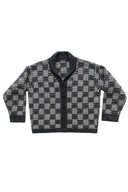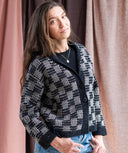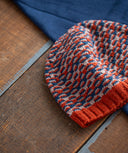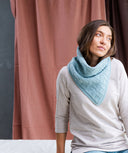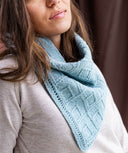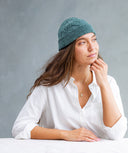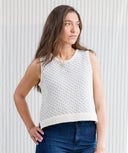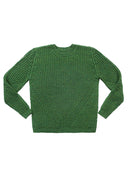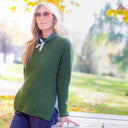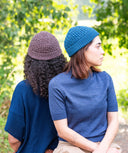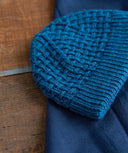Swatching 201
In Swatching 101, we discussed the technical aspects and practical benefits of swatching, specifically in the context of meeting gauge in a pattern, matching pattern schematics, and ensuring desired fit (especially for a garment). We also discussed foreseeing how a yarn will behave during knitting and after blocking. In this follow-up Foundations installment, we’ll talk about another approach to swatching: going beyond the gauge measurement and pursuing swatching as its own practice of creative exploration.

Gauge, Revisited
The kind of swatching that many of us may think of is typically project- or pattern-dependent and focuses on meeting technical requirements like gauge, with the end goal of simulating the fabric of your finished garment and achieving desired fit. In other words, it can be seen as the “required” first step (the sacrificial knitted square!) that stalls the fun of diving right in and seeing your fabric begin to grow.
While seemingly a chore, there are indeed many practical benefits to swatching for this purpose, especially if one is following a pattern and investing many hours in knitting. It is necessary to match a pattern’s listed gauge (the number of stitches and rows per inch) in order to ensure that your garment turns out as intended by the designer and written by the pattern writer. No two knitters knit the same — one may have a more relaxed tension while another may knit with a tighter tension, or one may be a picker and another a thrower — which makes gauge a very individual thing. By extension, one yarn can knit up into more than one kind of fabric, precisely because of the natural idiosyncrasies of making by hand.
The listed gauge in a pattern is an intentional decision made by a designer with regards to a very particular kind of fabric, which they develop through repeated swatching using different kinds of yarns and different needle sizes during the design process. (This is why the needle size listed in a pattern for working with a particular yarn may be different from the suggested needle size(s) printed on the ball band or label of that yarn.) This gauge measurement is the designer’s fingerprint for that particular design, and all the precise knitting math that happens to yield a knittable pattern is based on that measurement.
For example, if a designer’s stockinette stitch gauge with a worsted-weight yarn on a US 7 is 5 stitches/1”, a 150-stitch stockinette panel (say, for the front piece of a sweater) will measure 30” wide. If your stockinette stitch gauge with a worsted-weight yarn on a US 7 is 4 stitches/1”, then casting on and knitting the same number of stitches will yield you a 37.5” wide panel. This is 7.5″ inches wider than the intended dimensions of 30″ so you might consider going down a needle size.

Going Beyond the Gauge Measurement
When faced with all these variables, in addition to a strong desire to create something functional, well-fitting, and beautiful, it’s understandable that some worry may arise from the possibility of not meeting a required gauge. When that happens, the end point of swatching becomes: “I have to meet this gauge number!”
But let’s take a step back and explore this idea further. The purpose of swatching — and what makes it an amazingly invaluable tool in the knitter’s toolbox — is to simulate the fabric of your finished garment. The key point to recognize and remember is that, while getting gauge is immensely important when following a pattern, a gauge measurement is simply a way to communicate the characteristics of a knitted fabric made from a certain kind of yarn with a certain kind of knitting needle with a certain kind of stitch pattern. It is a descriptive tool, rather than a prescriptive tool. By telling you how many stitches and rows are in an inch of knitting, you may be able to gather from a gauge measurement whether the knitted fabric is loose or dense. However, there are more elements that go into your knitted fabric than this — namely, the very tactile feel of the fabric and the tactile feel of creating that fabric.
How does this feel? How will this drape? How will this wear? Will this textured stitch sing in this yarn, or will it be muted and camouflaged? Do these colors go well together? Will this be dense and warm? Will this be light and airy? Will this fabric hold up to the construction of the pattern? I’ve never tried this stitch before; do I enjoy working it? This yarn is new to me; do I enjoy working with it? I always use this yarn, but will it tell me something new this time?
These are the kinds of questions that swatching invites us to ask ourselves. It begs to be relied on as its own practice of play, exploration, creativity, and mindfulness, rather than as the routine first step to starting a project. The gauges listed in patterns are simply stated as starting points for one’s exploration of a certain kind of fabric. Again, the key is to establish the desired fabric first (through tactile inspection), then base desired measurements off of that fabric and its gauge. As an example, perhaps you’ve swatched for a pullover design and met the listed gauge for the pattern, but then realized that, while the fabric you achieved matched the pattern’s gauge measurement, it actually isn’t quite what you prefer. Perhaps you prefer a fabric that’s more substantial, or a fabric that’s looser. Perhaps the yarn choice just isn’t quite right. If we swatch without an eye out for these subtle (and not so subtle) individual preferences and the ways in which we can affect and be affected by our materials, then it makes perfect sense why we would approach swatching as something not so fun.
So, let’s say you dove right in and knit multiple swatches for a pattern and now have a number of options for the different kinds of fabrics you can make. But, what next? What if you’re not getting gauge at all, or if the gauge of the fabric you like best differs from the listed gauge in the pattern? Don’t fret! There are many ways to account for differences in gauge when knitting from a pattern — provided you’re on board for stepping out of your comfort zone. One simple way to adapt a knitting pattern to your gauge is to follow instructions for the smaller or larger size than what you’d normally follow. For example, if your gauge is looser (your stitches are larger and so your finished piece will be larger as well), you can follow the instructions for the size smaller than your normal size, resulting in a final size that’s closer to your desired fit. Our friends at Fringe Association and Tin Can Knits have wonderfully instructive resources for adapting your gauge to a pattern in this way (i.e. how to do the math!).

Thinking Outside the Swatch
What else can you do with your swatching explorations? If yardage isn’t a concern (i.e. you don’t need to unravel your swatch to use the yarn for your project), you can build a comprehensive swatch archive. Having a record you can go back to for easy reference can be amazingly handy. For example, if you have several stockinette swatches in multiple yarns you’ve tried using multiple needle sizes and suddenly have an itch to make an easy and cozy stockinette sweater, you can go through your archive and easily pick out which stockinette fabric you like the best (and the least!) and use that as a starting point. (Because numerous factors such as knitting style, needle type, and levels of relaxedness are unavoidable and will affect your tension, we still recommend swatching each time you start a project.) Andrea Rangel’s Swatch Project is a fascinating example of a well-developed and informative swatch archive.
You can also use your swatches as tools for planning your handmade wardrobe. You can use them to visually mix and match textures, colors, and yarns for either one garment or multiple garments and accessories that you intend to wear together. If you’re a sewer or a weaver, you can also experiment with pairing your knitted swatches with your fabric and woven swatches when envisioning and planning a me-made outfit. Your swatches don’t have to stay in your crafting nooks, either! They’re quite portable, so you can take them with you to stores to see how certain knitted fabrics look with ready-to-wear garments or fabrics at a fabric store.
Your swatch archive can also serve as your inspirational catalog or journal. If you’re brimming with ideas for different kinds of garments and accessories that use a multitude of exciting, challenging, and beautiful stitch patterns but don’t yet have the time to commit to a full project, you can “sketch” the idea by swatching and keep that swatch in your library so it’s ready for you to return to in the future. Likewise, swatching can be a low pressure way to experiment with colors or stitch patterns that are a bit out of your comfort zone but you’re still itching to try. Or, you can seam your swatches together and stuff them to create sweet-smelling sachets for taking inspiration with you on the go.
In sum, swatching can truly be a creatively fulfilling practice in its own right. In some respects, swatching is also just as much about getting acquainted with a yarn and a knitted fabric as it is about getting acquainted with yourself, your preferences, what sparks delight in your making, and the kind of maker you want to become. What an exciting idea, indeed!
